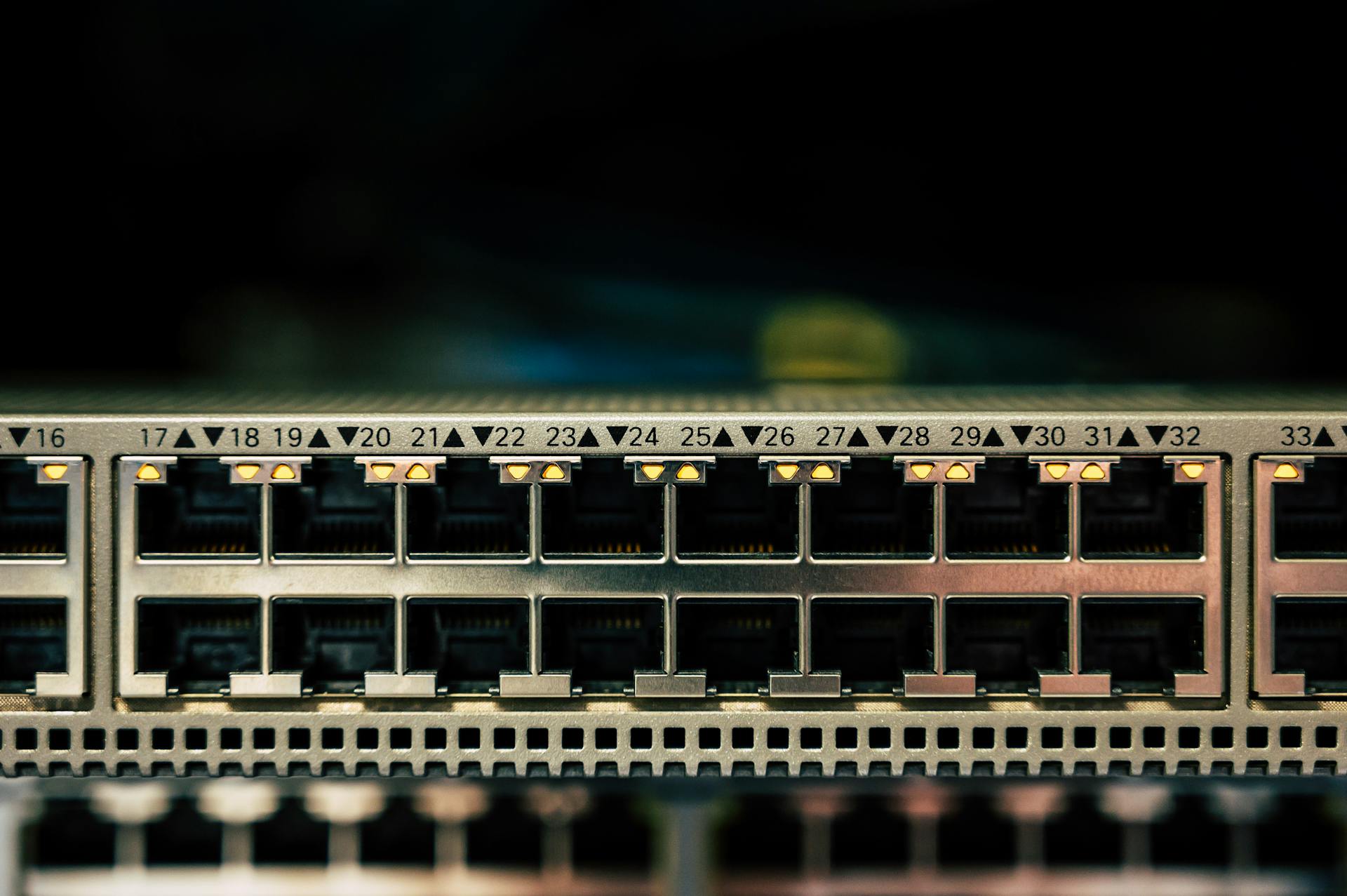
Stellar is a decentralized payment network that allows for fast, cheap, and secure transactions. It was created by Jed McCaleb, the co-founder of Ripple.
Stellar's main goal is to provide financial inclusion to the underbanked population around the world. It achieves this by making it easy to send, receive, and exchange money across different currencies.
The network uses a unique consensus algorithm called the Stellar Consensus Protocol (SCP) to validate transactions. This algorithm is designed to be fast and energy-efficient.
Stellar's native cryptocurrency is called lumens (XLM), which serves as a bridge currency to facilitate cross-border transactions.
Worth a look: Co-founder Animoca Brands - Yat Siu
How Stellar Works
The Stellar network uses a consensus algorithm called the Stellar Consensus Protocol (SCP), which enables fast transactions at lower costs. This protocol allows the network to reach an agreement on a transaction's validity within a few seconds.
Each participant on the network, called a node, selects a mini-network of other trusted participants, known as Quorum Slices. These mini-networks overlap to ensure the network can reach a consensus quickly.
On a similar theme: Will Stellar Lumens Reach $1
The Stellar network has an open ledger system, where all transactions are stored on the blockchain. This ledger system is transparent and accessible to all users, allowing them to view every transaction.
The Stellar network allows users to exchange between fiat and digital currencies through anchors, which are regulated financial institutions that issue fiat-backed stablecoins. This enables users to send and receive money quickly and transparently, without the fees and latency traditionally associated with cross-border and cross-currency remittances.
Take a look at this: What Is Square Payment System
How Payment Systems Work
Payment systems can be complex, but they're based on simple principles.
In the Stellar payment system, banks are linked to the network as "Anchors."
These anchors, like Bank A and Bank B, communicate with each other to facilitate transactions.
When Janet sends Keith $5000, the transaction intent is sent to Bank B within seconds to check for compliance.
The moment Bank A receives approval from Bank B, they deduct the funds from Janet's account.
The USD is then transferred to Bank A's pool account and moved as XLM into the Stellar network.
Once inside the Stellar network, the money looks for the best exchange rate to convert the XLM into GBP.
The money then moves to Bank B's base account, which gets credited to Keith's account.
Network Programming Languages
Network programming languages are a crucial part of Stellar's architecture. They enable developers to build and interact with the Stellar network.
Java is one of the programming languages used on Stellar, specifically for its Java SDK. This SDK allows developers to build Java applications that interact with the Stellar network.
Python is also used on Stellar, specifically for its Python SDK. This SDK is a popular choice among developers due to its simplicity and ease of use.
C++ is another programming language used on Stellar, specifically for its C++ SDK. This SDK is used for building high-performance applications that require low-level memory management.
These programming languages provide the foundation for building applications that interact with the Stellar network, enabling users to send and receive assets securely and efficiently.
Network Components
The Stellar network is a decentralized payment system that operates peer-to-peer, without central management. This means that transactions are processed and verified by the network as a whole, rather than by a single entity.
The network is made up of various components, each playing a crucial role in facilitating transactions. The components of the Stellar system include the decentralized system itself.
Stellar's decentralized system allows for the free flow of information and value between participants. This is made possible by the absence of a central authority or intermediary.
In a decentralized system, trust is established through a consensus mechanism, where network participants verify and validate transactions. Stellar's system relies on this type of consensus mechanism to ensure the integrity of transactions.
Consider reading: P2p Bitcoins
Blockchain Protocol
The Stellar blockchain protocol is a game-changer for cross-border transactions. It uses a consensus mechanism called the Stellar Consensus Protocol (SCP), which is based on the Federated Byzantine Agreement (FBA).
The SCP allows for fast and efficient transactions, with an average confirmation time of 3-5 seconds. This is made possible by the network's ability to reach a consensus on valid transactions quickly.
The Stellar network is decentralized and open-source, allowing for a high degree of transparency and security. The SCP also enables the network to support thousands of transactions per second.
Here are some key features of the Stellar blockchain protocol:
The SCP is a highly scalable messaging platform that matches up offers to sell with offers to purchase at a rate of thousands per second. This makes it an ideal platform for cross-border transactions and financial services.
The Stellar network's built-in features, such as its API Horizon and the growing tools and products available to the ecosystem, create an environment where it's easy for businesses and developers to build on the network and leverage its most compelling features.
Take a look at this: Online Banking Features
Smart Contracts and Assets
Smart contracts on Stellar are made possible through Soroban, a Turing complete smart contract development platform built on WASM. Soroban is now live on Futurenet, allowing developers to write and deploy smart contracts in a test environment and be rewarded for it.
Soroban smart contracts are designed to scale and provide reliable access to financial rails through the Stellar network. They also come with a batteries-included developer experience. The Soroban Adoption Fund has allocated $100M to developers who create products and tools that support the Soroban ecosystem.
Assets on Stellar are unique in that they don't represent actual physical goods or currencies, but rather a credit issued by someone on the network. This is why you can have multiple tokens representing the same asset, such as USD_COOL, EURO_COOL, and PKR_COOL, each with its own issuer address.
Here are the key functions of XLM, the native digital currency of the Stellar network:
- Facilitate transactions with a nominal fee to deter spamming
- Act as a bridge currency in cross-border transactions
- Maintain network security by requiring a minimum balance of 1 XLM to open an account
- Provide liquidity in the Stellar decentralized exchange
- Enable access to financial services, including payments, remittances, and micropayments
Smart Contracts
Smart contracts are a fundamental aspect of the Stellar network, allowing developers to create complex financial applications and services. The Stellar Development Foundation has announced plans to bring Turing complete smart contracts to Stellar, which will be launched on the Soroban platform.
Soroban, Stellar's smart contract development platform, is now live on Futurenet and allows developers to write and deploy smart contracts in a test environment. This is a significant step towards expanding financial services access on the Stellar network.
Turing complete smart contracts, like those on Soroban, are built on WASM and offer a batteries-included developer experience. This means developers can create complex smart contracts with ease.
The Soroban Adoption Fund has allocated $100M to developers who create products and tools that support the Soroban ecosystem. This will likely lead to the creation of new financial applications and services on the Stellar network.
While Stellar's smart contracts are not Turing complete, they offer simple smart contract capabilities through multi-signature accounts, batching transactions, and time-bound functions. This design choice prioritizes network performance and security.
If this caught your attention, see: Smart Contract Platforms
Soroban smart contracts are designed to scale and provide reliable access to financial rails through the Stellar network. This is a significant advantage over other blockchain platforms that may struggle with scalability.
Developers can start testing Soroban smart contracts now and receive rewards for their contributions. This is a great opportunity for developers to get involved in the Stellar ecosystem and create innovative financial applications.
Discover more: Ethereum Smart Contract
Assets and Tokens - XLM
XLM, or 'Lumens', is the native digital currency of the Stellar network, designed to facilitate multi-currency transactions and prevent spam on the network.
XLM is used to pay for transaction fees on the Stellar network, with a nominal fee of 0.00001 XLM per transaction to deter spamming.
To open an account on the Stellar network, a minimum balance of 1 XLM is required to prevent ledger spam and ensure all accounts are genuine.
XLM can function as an intermediary currency in transactions between different currencies on the Stellar network, facilitating cross-border transactions quickly and efficiently.
Explore further: Electronic Transaction for Payment Explanation
In the Stellar decentralized exchange, XLM can be used to trade against all other forms of currency or tokens issued on the network, making it a key liquidity provider.
XLM enables access to financial services on the Stellar network, including payments, remittances, and micropayments, which are faster and cheaper than traditional banking systems.
The Stellar network supports creating and exchanging various digital assets and custom tokens that can represent fiat currencies, commodities, or any other form of value.
These assets can be traded on Stellar's decentralized exchange, ensuring users can seamlessly transact in their preferred currency without worrying about the conversion process.
Here are the key functions of XLM:
Storing XLM
Storing XLM requires a robust solution, especially for long-term holding or substantial amounts.
Hardware wallets are a top choice for securing Stellar (XLM) holdings, as they store cryptocurrency offline in "cold storage", insulating them from online vulnerabilities and hacking threats.
A look at some of the best hardware wallet solutions can be found HERE.
For those unsure of hardware wallets, Stellar (XLM) is also widely supported by non-custodial software wallets.
A look at some of the best software wallet solutions can be found HERE.
Choosing the right storage option is crucial for Stellar (XLM) users, with hardware and non-custodial software wallets providing a secure solution for substantial investments and long-term holding.
A different take: Non Fungible Token
Use Cases and Applications
Stellar has a wide range of applications beyond financial markets, making it an attractive option for organizations looking to safely perform essential functions.
The Stellar blockchain has numerous possibilities and applications, including anchors in more currencies, mobile and trading clients, API Mashups, and merchant plugins.
One potential application of the Stellar blockchain is in creating micro savings accounts for specific purposes like school, health, or insurance. This can help individuals save small amounts of money for specific goals.
P2P lending and microinsurance are also possible applications of the Stellar blockchain, allowing for more efficient and secure transactions.
A Stellar blockchain explorer can provide real-time information on the blockchain, including live insights on recently mined blocks and detailed statistics on assets.
Stellar's architecture and features make it well-suited for various financial services, including micropayments, remittances, mobile banking, and token issuance.
Here are some potential applications of the Stellar blockchain:
- Anchors in more currencies
- Mobile and trading clients
- API Mashups
- Merchant plugin
- Micro savings account for school, health, insurance
- Microinsurance
- P2P lending
- Conditional cash transfers
- Donation systems for nonprofits
- Loyalty points programs
- Community currencies
- Time banks
- Volunteer hour tracking
- Anywhere ATM or human ATM mobile apps
Uphold is one of the top exchanges for United States residents that offers a wide range of cryptocurrencies, with Germany and Netherlands being prohibited.
XLM and Trustlines
XLM and Trustlines are two key concepts in the Stellar network. XLM, or Lumens, is the native digital currency used to facilitate transactions and prevent spam on the network. It's used to pay for transaction fees and acts as a bridge currency for cross-border transactions.
XLM also plays a crucial role in maintaining network security by requiring a minimum balance of 1 XLM to open an account. This ensures that all accounts on the network are genuine and prevents ledger spam. Additionally, XLM provides liquidity in the Stellar decentralized exchange, enabling users to convert between different assets easily.
A trustline is an agreement between an asset issuer/anchor and asset holder, similar to a contract between a customer and a merchant. It's established when a user gives cash money to an asset issuer, and in return, they receive a token that represents a specific asset. Without a trustline, a transaction of the token is not possible.
Expand your knowledge: Crypto Asset Security
Lumens (XLM)
Lumens (XLM) are the native digital currency of the Stellar network, designed to facilitate multi-currency transactions and prevent spam on the network.
XLM is used to pay for transaction fees on the Stellar network, with a nominal fee of 0.00001 XLM per transaction. This fee helps deter spamming the network with frivolous or malicious transactions.
To open an account on the Stellar network, a minimum balance of 1 XLM is required. This requirement is intended to prevent ledger spam and ensure that all accounts on the network are genuine.
XLM can function as an intermediary currency in transactions between different currencies on the Stellar network. This feature is particularly useful in cross-border transactions where there might not be a direct market between the two currencies involved.
Explore further: Why Is Bitcoin Network Fee so High
XLM is also used as a bridge currency to facilitate these exchanges quickly and efficiently.
Here are the key functions of XLM:
- Facilitate Transactions: XLM is used to pay for transaction fees on the Stellar network.
- Act as a Bridge Currency: XLM can function as an intermediary currency in transactions between different currencies on the Stellar network.
- Maintain Network Security: A minimum balance of 1 XLM is required to open an account on the network.
- Provide Liquidity: XLM can be used to trade against all other forms of currency or tokens issued on the network.
- Enable Access to Financial Services: XLM enables access to financial services on the Stellar network, including payments, remittances, and micropayments.
Trustlines
Trustlines are a crucial part of the Stellar network, allowing transactions to happen between two parties.
A trustline is essentially an agreement between an asset issuer, also known as an anchor, and an asset holder. This agreement is established when you give cash money to a counter boy, and in return, he gives you a token for a plate of Biryani, which you can redeem later.
The token itself has no worth without the trust established between you and the Biryani shop owner. Similarly, in the Stellar world, a transaction of a token is not possible unless a trustline is established between the asset issuer and the asset holder.
In essence, trustlines are the foundation of the Stellar network, enabling transactions to happen between two parties that have established a trust relationship.
You might enjoy: What Is Grayscale Bitcoin Trust
Development and Growth
Stellar's development and growth have been marked by significant milestones, including its establishment as a platform for Initial Coin Offerings (ICOs) by 2017. This led to partnerships with major companies like IBM, showcasing Stellar's potential in facilitating international banking transactions.
In 2019, the Stellar Development Foundation (SDF) made a bold move by burning 55 billion XLM tokens, aiming to streamline the token's supply and potentially enhance its value. This move was a strategic step towards financial inclusion.
To develop on the Stellar network, one can install the Stellar SDK for Python using pip, which generates a public and private key.
Reinventing Itself (2015)
In April 2015, Stellar made a pivotal move by introducing the Stellar Consensus Protocol (SCP), marking a departure from its Ripple-based roots.
This new protocol was designed to enhance network security and decentralization, laying the groundwork for Stellar's future growth.
Stellar's mission to improve financial inclusivity remained unchanged, but the SCP provided a unique approach to consensus that ensured scalability and inclusivity.
The year 2015 was characterized by infrastructural improvements and partnership developments, aiming to solidify Stellar's foundation.
The SCP was a significant early development work that helped Stellar realize its vision of connecting different financial systems worldwide.
Growth and Recognition
By 2017, Stellar had established itself as a platform for Initial Coin Offerings (ICOs), attracting projects with its efficient and scalable network.
Stellar's partnership with IBM in 2017 showcased its potential in facilitating banking transactions across borders, demonstrating its ability to work with established institutions.
The following year, Lumens (XLM) experienced significant market growth, benefiting from the broader cryptocurrency boom and leading to increased network adoption.
This growth marked a turning point for Stellar, as it solidified its position in the cryptocurrency market and set the stage for future expansion.
Strategic Developments (2019-2020)
In 2019, the SDF made a bold move by burning 55 billion XLM tokens to streamline the token's supply and potentially enhance its value.
Stellar doubled down on its mission of financial inclusion, recognizing the network's utility in global financial services.
The integration of USDC, a leading stablecoin, expanded Stellar's capabilities in global financial services.
Coinbase, a publicly traded exchange, accepted residents from over 100 countries, including major economies like the United States, the United Kingdom, and Australia.
A unique perspective: Payment for Medical Services
Frequently Asked Questions
Who owns the Stellar Network?
The Stellar Network is controlled by the Stellar Development Foundation, a centralized entity that holds a significant share of lumens tokens. This has raised concerns among critics about the network's decentralization.
Sources
- https://www.leewayhertz.com/what-is-stellar-blockchain/
- https://www.gemini.com/cryptopedia/stellar-blockchain-payments-xlm-coin
- https://thetechnologyvault.com/introduction-stellar-payment-network
- https://www.securities.io/investing-stellar/
- https://blog.adnansiddiqi.me/how-to-create-a-custom-token-on-stellar-network-in-python/
Featured Images: pexels.com


